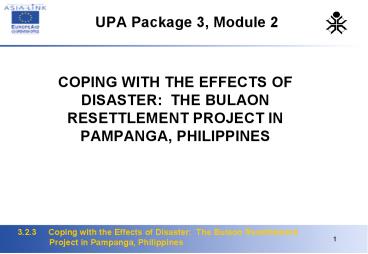UPA Package 3, Module 2 - PowerPoint PPT Presentation
1 / 28
Title:
UPA Package 3, Module 2
Description:
... with the Effects of Disaster: The Bulaon Resettlement Project in ... COPING WITH THE EFFECTS OF DISASTER: THE BULAON RESETTLEMENT PROJECT IN PAMPANGA, ... – PowerPoint PPT presentation
Number of Views:56
Avg rating:3.0/5.0
Title: UPA Package 3, Module 2
1
UPA Package 3, Module 2
COPING WITH THE EFFECTS OF DISASTER THE BULAON
RESETTLEMENT PROJECT IN PAMPANGA, PHILIPPINES
2
Objectives
- Gain insight into extent of destruction of
natural disasters - Become familiar with the nature and extent of
problems met - Learn possible ways of coping with large-scale
problems caused by disasters
3
Eruption of Mt Pinatubo
4
Damages Church
5
Damages Public Market
6
Damages Affected Population
3.2.7 Coping with the Effects of Disaster
The Bulaon Resettlement Project in Pampanga,
Philippines
7
- Policy Response RA 7637
- Set up funds
- Created Mt. Pinatubo Commission
8
Resettlement Strategy
Vision resettlement centers will become venues
for development and provide the region a model
for re-engineering.
9
- Two Types of Settlements
- Upland settlement for Aetas
- Lowland settlement for lowlanders
10
- Features Upland Settlements
- Foot trails and bridges, springs and artesian
wells, school buildings, public markets, staff
house - main livelihood contract reforestation and
agricultural production
11
- Concepts Lowland Settlements
- novel approach to resettlement
- focused development - limit dependency on
dole-outs - concept of social regeneration - a holistic
approach to socio-economic progress
12
- The Actors
- Department of Environment and Natural Resources
- Department of Agrarian Reform
- Philippine Institute of Volcanology
- Technology and Livelihood Center
- Social Services Administration
- Department of Public Works and Highways
- Philippine Institute of Civil Engineers
- Association of Structural Engineers
- Local Government Units
- Non-Governmental Organizations
13
Resettlement Sites
Resettlement Sites as of February 1999
The following were the resettlement sites of the
Mt. Pinatubo victims
14
Resettlement Sites (continued)
15
Resettlement Sites (continued)
16
Bulaon Resettlement Sites
17
Bulaon Resettlement Project
- 79.7 hectares of flat land
- Opened for occupancy in 1995
- Capacity 4,053 housing units
- As of June 30, 1999
- 4,033 families resettled
- 20,342 individuals
18
Project Features
- The Bulaon Resettlement site followed the basic
design of the lowland sites. The layout of the
lowland settlements was visualized as a
functional community environment with each site
having the following features - A new townsite developed as a model community,
not squatter ghettos - Paved roads with sidewalks with street lighting
- Power system supplied by the local electric
cooperative
19
- Drainage system
- Level 3 water system
- School buildings for elementary and high schools
- A government or administration building (similar
to a town hall) - Town plaza with open playground
- Public market and commercial stalls
20
- A hospital or clinic
- A livelihood training center
- A site assigned for religious worship
- Productivity center (a cluster of four to six
factory buildings) - Adequate greenery
- Housing of lot sizes ranging from 50 to 150
square meters
21
Resettlement Components
- Resettlement
- Social Services
- Infrastructure
- Livelihood
- Estate Management
22
The Resettlement Prosses
- Site Selection
- Consultations
- Site Planning
- Approval of Site Plan
- Site Development
- Transfer of Settlers
- Assistance and Loan Package
23
Priority Beneficiaries
- Families who lost houses and livelihood
- Families who lost houses
- Shares/renters of houses lost
- Families living in high risk areas
- Families less severely affected
24
Benefits from Project
- 90 of resettlers have remained
- Bulaon is a bustling community
- Internal revenue allotment increased
- Bulaon is now the biggest barangay its officials
receive higher salaries because of its size - Accessibility - Bulaon used to be inaccessible
- Growth in commercial activities
25
Resettlement Public Market
26
Grandiose House in Resettlement Area
27
Resettlement Issues
- Mismatch between settlers felt needs and
governments perception of their needs - Floor area of house too small for some
- Inadequate livelihood opportunities
28
Lessons Learned
- Program of assistance must be holistic
- Gainful employment must be provided
- Individual and collective needs, including
physical and non-physical needs must be considered































